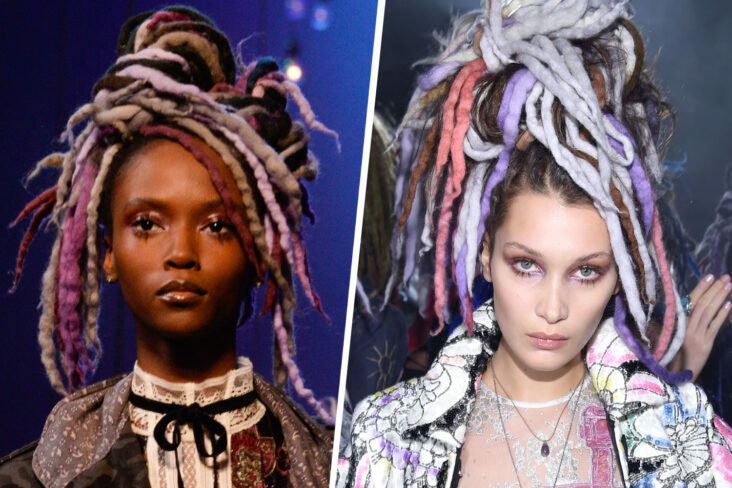The pharaohs wore dreads, but their first literary mention is said to be in the Hindu Vedic scriptures dating from around 1700BC. The God Shiva wore ‘matted’ dreadlocks.
Cepandant, What race started dreadlocks?
Historians and anthropologists have found evidence of the ‘do in ancient Egypt, Germanic tribes, Vikings, Pacific Islanders, early Christians, the Aborigines and the New Guineans as well as the Somali, the Galla, the Maasai, the Ashanti and the Fulani tribes of Africa.
Aussi, Did Vikings actually have dreads?
Viking warriors usually wore long braids or dreadlocks to make them more intimidating to their enemies in battle – or perhaps, more simply, for the practical purpose or keeping their hair out of their eyes while fighting!
Did Haile Selassie have dreadlocks? Dreadlocks’ roots were planted in Africa when Ras Tafari was crowned Emperor Haile Selassie I in 1930. After Italy invaded Ethiopia, guerrilla warriors vowed not to cut their locked hair until their « lion of Judah, » Selassie, was freed from exile.
Toutefois, Did Vikings start dreadlocks?
Historians have uncovered Roman accounts stating that the Celts wore their hair “like snakes” and that several Germanic tribes and Vikings were known to wear dreadlocks.
Did the Vikings wear dreads?
Historians have uncovered Roman accounts stating that the Celts wore their hair “like snakes” and that several Germanic tribes and Vikings were known to wear dreadlocks.
Can dreadlocks be undone?
You can « unlock » your dreadlocks without cutting them, but the process will take a long time. Short locks that have only been around for a year or less might come undone within four to eight hours. Longer locks that you’ve had for multiple years may take 15 to 48 hours.
Are dreads African?
Although dreadlocks have been worn continuously by people of colour in Africa, Asia, and the Americas from ancient times until now, their popularisation in the West only occurred in the Seventies. This was due to the success of Jamaican-born reggae artist Bob Marley following his conversion to Rastafarianism.
Did dreadlocks originated in Africa?
According to The Encyclopedia of Hair, A Cultural History, the oldest historical record of an African tribe rocking locs can be credited to the priests of the Ethiopian Coptic religion, who were wearing the style as early as 500 BCE.
What cultures had dreadlocks?
Egyptians have been credited as the first culture to have dreadlocks since they have been discovered on mummies. Since then, others such as Romans, Greeks, Vikings, Indians, Christians, Germans, and Africans have also incorporated dreads into their cultures.
Did the Scottish have dreadlocks?
Seriously. “Well, the Celts did have dreadlocks. The Romans reported Celtic warriors as having “hair like snakes,” which has been taken to imply that they had dreadlocks. Its also been recorded that Germanic tribes, Greeks, and Vikings often wore dreadlocks as all.
How is Rastafari different from Christianity?
Furthermore, Rasta symbols and codes are challenging Christianity too: God is embodied in Jesus Christ for Christians and in Haile Selassie I for Rastas; Christians see Moses as the prophet who led the Hebrew slaves out of Egypt while Rastas see Marcus “Mosiah” Garvey as Jamaica’s Redeemer with his back-to-Africa …
Why is Selassie the messiah?
As emperor of Ethiopia (1930–74), Haile Selassie I was known for modernizing his country, for helping to establish the Organization of African Unity (now the African Union) in 1963, for his exile (1936–41), and for being overthrown in 1974. He was also regarded as the messiah of the African race by many Rastas.
Why do Rastas cut their hair when someone dies?
Why do some Rastafari choose not to hold funerals? Within Rastafari there is no death, that’s one of the key things. They are spiritual beings having a physical experience, so within that there is no death. As a Rasta, in days of old, and still in some cases today, when you go to a funeral, you then cut your dreads.
Did pirates have dreadlocks?
So, pirates did look like Captain Jack Sparrow? Probably not the eyeliner, though many pirate captains wore rich velvet waistcoats and foppish big hats with feathers. The legendary Blackbeard sported dreadlocks and liked to braid his long beard and tie it in ribbons.
Did Aztecs have dreadlocks?
Pre-Columbian Aztec priests were described in Aztec codices (including the Durán Codex, the Codex Tudela and the Codex Mendoza) as wearing their hair untouched, allowing it to grow long and curl around itself.
How much does it cost to take down dreads?
Dreadlocks price list
| Dreadlocks creation method | Cost |
|---|---|
| Partial head | Starts at $300 |
| Soft crochet | Starts at $200 |
| Faux lock extensions | Starts from $300 up to $800 |
| Wool dreadlocks | $150 to $300 |
Why do dreads smell?
Mold can grow in your dreadlocks (i.e., dread rot) if your hair isn’t properly dried after washing. It produces a mildew-like smell that’s really tough to get rid of. Environmental odors. Odors out of your control, like air pollution, scents from food, and smoke, can also settle in your dreads and produce an odor.
How do I Unplait My locked hair?
To comb out dreads, you’ll need to wet the hair and smother it with a lubricating conditioner to get started. Then you’ll use a pick or metal comb to very patiently start picking out the hair from the tip of the dreadlock working toward the scalp.
Did Samson have dreadlocks?
Who is Samson and why are his dreadlocks relevant? Samson, we are all aware, was a man who’s dreadlocks were said to be the source of his power and strength. But the story goes much deeper than that. When we hear of Samsons locks, we only hear of Samson and Delilah, But that’s only one half of a 5 chapter story.
N’oubliez pas de partager l’article ✨

